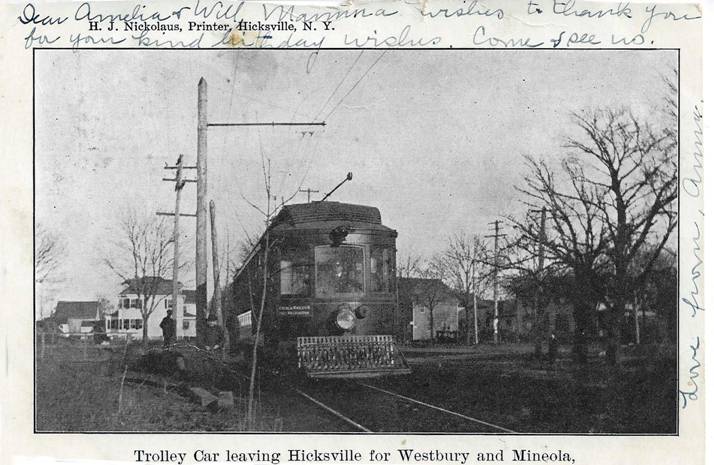Description of the Trolley Service
The Hicksville terminus of the NY&NS system was not impressive: a single track on unpaved Broadway, extending between John Street and the south side of Depot Square. The track and wire simply ended - or, from the viewpoint of the people of Hicksville, they began - at the LIRR crossing.

Route through Downtown Hicksville adapted from Belcher-Hyde 1914 Atlas of Nassau County
The headquarters of the NY&NS were in Rosyln, from which the line's original tracks extended south, north and west. The branch to Hicksville was newer. When it first opened, it did not connect with the rest of the system; Hicksville trolleys could go only as far west as Mineola. They departed from Depot Square hourly on the half-hour, from 6:30 AM to 9:30 PM. In the warmer months, service was half-hourly.
In July of 1909, the Hicksville branch was connected to the main trackage; alternate departures ran to Port Washington, traveling the 16.5 miles in 80 minutes. Hicksville residents later could enjoy through service to Flushing.
The line's trolleys were new, built to endure the demands of traveling the countryside between towns; people thought them handsome. Exteriors were a greyed green, with the company's initials lettered in gold. Car numbers and fine stripes were a cream color; the wood of the window sashes was covered with clear varnish. Interiors were pale green. The trolleys had plenty of windows, with a clerestory overhead. Seats were upholstered with woven rattan, and a boiler provided hot water heating in cold weather.

Interior of NY&NS Trolley from Seyfried, NY & NS Traction Company
For safety's sake, window openings had guards, as can be seen above. Guards were necessities - even with them, one passenger managed to thrust her arm out an open window, and promptly had it broken by a trolley passing in the other direction. After this incident, the window guards were extended higher than before.
A standard trolley gong ("Clang! Clang! Clang! went the trolley...") warned too-close traffic and pedestrians; a distinctive whistle announced the trolley's approach as it neared rural crossings. Hung at the front end of the cars was a basket-like contraption (known as an Eclipse Fender, visible in the photo below). If it struck anything or anyone, it would lower itself, scooping up the "prey" and preventing its being run over as the trolley stopped.

collection of Mark Thomas, HHS Class of 1975; used with permission
This photo speaks to the company's professionalism: there are two overhead power wires, side by side, although a trolley only needed one. Why two? Using one overhead wire for trolleys running in both directions caused excessive wire wear, leading to more frequent power disruptions. Having two wires, one eastbound and one westbound, cost more money - but service was more reliable.
In general, 5¢ took riders to Mineola or Rosyln, a supplemental fare got them to the edge of Queens, and another took them to Flushing. To better understand the routes of the NY&NS, and to see along which roads they were built, see the detailed map in this article's Appendix.

